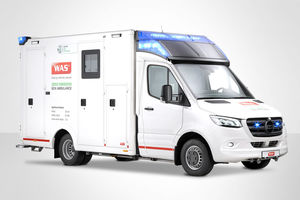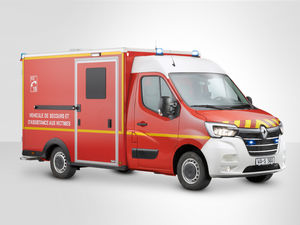
- Primary care
- Emergency medicine, Resuscitation
- Box ambulance
- WAS - Wietmarscher Ambulanz- und Sonderfahrzeug
Box ambulance WAS 500 type A24-stretcherautomatic
Add to favorites
Compare this product
Characteristics
- Configuration
- box
- Type
- type A2
- Other characteristics
- 4-stretcher
- Transmission
- automatic
- Tare weight
3,500 kg
(7,716 lb)- Total length
5,750 mm
(226.4 in)- Total width
2,110 mm
(83.1 in)- Total height
2,810 mm
(110.6 in)
Description
The trend towards lightweight box construction in emergency rescue is also becoming more and more prevalent in patient transport. The classic ambulance as a panel van is increasingly being replaced by a chassis with a box body. When procuring a new patient transport ambulance, or even an entire ambulance fleet, the box body’s comparatively cheaper purchase price for the basic vehicle is persuading buyers. In addition, once the base vehicle has reached its maximum permitted mileage, the box can be re-used on another vehicle chassis. An investment with room for improvement, given that, with advancements in medical technology, the requirements placed, for example, on stretcher systems are also becoming more demanding. The result of this is that technical and qualitative stipulations are increasing the weight and the dimensions of electro-hydraulic stretchers. Here, the lightweight box offers further benefits: it not only helps to cut down weight, so as not to exceed the generally stipulated maximum total weight of 3.5 t, but also guarantees more space within the patient compartment.
All that remains to be addressed is the housing of the equipment: in the case of the box body ambulance, scoop stretchers or combi-carriers are kept behind an access door on the outside of the vehicle, and are thus stored without any problem, outside of the patient compartment.
The geometry of the panel construction even allows hassle-free storage space for other equipment, for instance, for use as an emergency ambulance, as the box construction has no shaped chassis design to be taken into consideration.
Exhibitions
Meet this supplier at the following exhibition(s):

Other WAS - Wietmarscher Ambulanz- und Sonderfahrzeug products
WAS 500 Box Body Ambulances
Related Searches
- WAS ambulance
- WAS van ambulance
- Mobile health vehicle
- Truck mobile health vehicle
- WAS ambulance with oxygen therapy
- WAS box ambulance
- Type A ambulance
- WAS type B ambulance
- Off-road ambulance
- WAS diesel ambulance
- WAS automatic ambulance
- WAS type C ambulance
- Intensive care ambulance
- Manual ambulance
- Emergency mobile health vehicle
- WAS rescue ambulance
- 4-stretcher ambulance
- Electric ambulance
- Box body mobile health vehicle
- Transfer ambulance
*Prices are pre-tax. They exclude delivery charges and customs duties and do not include additional charges for installation or activation options. Prices are indicative only and may vary by country, with changes to the cost of raw materials and exchange rates.















